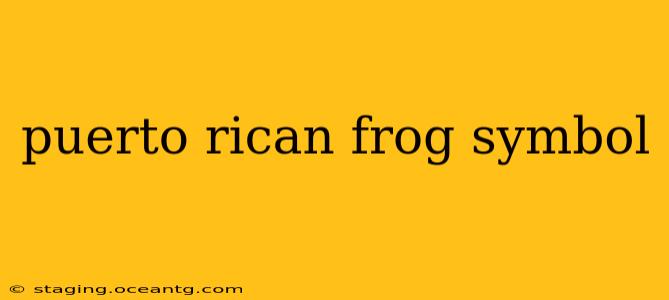The tiny, melodious call of the coquí frog echoes through the lush forests of Puerto Rico, instantly transporting anyone who hears it to the island's enchanting landscape. More than just a charming amphibian, the coquí has become a powerful symbol of Puerto Rican identity, deeply embedded in the island's culture and national pride. This article will explore the multifaceted significance of this tiny frog, answering frequently asked questions about its symbolic role.
What is the significance of the coquí frog in Puerto Rican culture?
The coquí's cultural importance stems from its unique connection to the island's natural beauty and its enduring presence throughout Puerto Rican history. It's a symbol of:
- National Identity: The coquí's distinctive call is instantly recognizable as a hallmark of Puerto Rico. Hearing it evokes a sense of home and belonging for Puerto Ricans, both on and off the island. It's a constant reminder of their heritage and roots.
- Environmental Conservation: The coquí is also a symbol of the island's fragile ecosystem. Its survival is intrinsically linked to the health of Puerto Rico's forests and environment. Protecting the coquí has become synonymous with preserving the island's natural beauty.
- Resilience and Perseverance: The coquí’s ability to thrive in diverse environments mirrors the resilient spirit of the Puerto Rican people. The frog has endured various environmental challenges and continues to flourish, embodying the island’s strength in the face of adversity.
- Magical and Spiritual Beliefs: In some aspects of Puerto Rican folklore, the coquí is associated with good luck and positive energy. Its call is often seen as a soothing and comforting sound.
What does the coquí frog symbolize in Puerto Rican folklore?
While not as prominent as other symbolic elements in Puerto Rican folklore, the coquí does hold a place in certain beliefs. It's often associated with positive energy, luck, and the enchantment of the rainforest. Some believe its call carries a mystical significance, connecting the living world to the spiritual realm. Stories and legends surrounding the coquí are less prevalent than those concerning other creatures, but its presence in the folklore contributes to its overall cultural importance.
Why is the coquí frog a national symbol of Puerto Rico?
The coquí's status as a national symbol is multifaceted. Its unique call is inextricably linked to the island, serving as an auditory identifier for Puerto Rico. Moreover, the frog’s image is prominently featured on various merchandise and promotional materials, representing the island's beauty and identity to the world. Finally, its importance in conservation efforts elevates its status beyond a simple emblem and transforms it into a potent symbol representing the island's ecological stewardship.
What are some examples of the coquí frog in Puerto Rican art and media?
The coquí’s image appears frequently in various forms of Puerto Rican art and media:
- Music: The coquí's call has been incorporated into musical compositions, often used to evoke a feeling of nostalgia and longing for the island.
- Literature: The coquí frequently features in Puerto Rican literature as a symbol of nature, home, and national identity.
- Visual Arts: The coquí is a popular subject in paintings, sculptures, and other visual arts forms, reflecting its cultural significance.
- Tourism: The coquí is widely used in tourism marketing and branding, acting as an instantly recognizable image for Puerto Rico.
Is there more than one type of coquí frog?
Yes, there are several species of coquí frogs in Puerto Rico, each with its own unique call. The most common and well-known is the Eleutherodactylus coquí, which is often simply referred to as the coquí. However, the broader term "coquí" encompasses many other species, all contributing to the rich biodiversity of the island.
The coquí frog is far more than just an amphibian; it's a symbol that encapsulates the spirit, resilience, and beauty of Puerto Rico. Its enduring presence in the island's culture and folklore ensures its continued relevance as a vital emblem of Puerto Rican identity.
